DRAFT INTERNATIONAL STANDARD
ISO/TC 22/SC 31
Voting begins on:
Secretariat: DIN
Voting terminates on:
ISO/DIS 15118-8
2016-06-10
2016-09-01
Road vehicles — Vehicle to grid communication
interface —
Physical layer and data link layer requirements for
wireless communication
Vehicules routiers — Interface de communication entre vehicule et reseau electrique
Part 8:
ICS: 43.120
THIS DOCUMENT IS A DRAFT CIRCULATED
FOR COMMENT AND APPROVAL.
IT
IS
THEREFORE SUBJECT TO CHANGE AND MAY
NOT BE REFERRED TO AS AN INTERNATIONAL
STANDARD UNTIL PUBLISHED AS SUCH.
IN ADDITION TO THEIR EVALUATION AS
BEING ACCEPTABLE
INDUSTRIAL,
FOR
TECHNOLOGICAL,
COMMERCIAL
AND
USER PURPOSES, DRAFT
INTERNATIONAL
STANDARDS MAY ON OCCASION HAVE TO
BE CONSIDERED IN THE LIGHT OF THEIR
POTENTIAL TO BECOME STANDARDS TO
WHICH REFERENCE MAY BE MADE
IN
NATIONAL REGULATIONS.
RECIPIENTS OF THIS DRAFT ARE INVITED
TO SUBMIT, WITH THEIR COMMENTS,
NOTIFICATION OF ANY RELEVANT PATENT
RIGHTS OF WHICH THEY ARE AWARE AND TO
To expedite distribution, this document is circulated as received from the
committee secretariat. ISO Central Secretariat work of editing and text
composition will be undertaken at publication stage.
Reference number
ISO/DIS 15118-8:2016(E)
© ISO 2016
--`,`,,`,`,,`,`,``,``,,,,`,``,,,-`-`,,`,,`,`,,`---�
ISO/DIS 15118-8:2016(E)
COPYRIGHT PROTECTED DOCUMENT
© ISO 2016, Published in Switzerland
All rights reserved. Unless otherwise specified, no part of this publication may be reproduced or utilized otherwise in any form
or by any means, electronic or mechanical, including photocopying, or posting on the internet or an intranet, without prior
written permission. Permission can be requested from either ISO at the address below or ISO’s member body in the country of
the requester.
ISO copyright office
Ch. de Blandonnet 8 • CP 401
CH-1214 Vernier, Geneva, Switzerland
Tel. +41 22 749 01 11
Fax +41 22 749 09 47
copyright@iso.org
www.iso.org
ii
© ISO 2016 – All rights reserved
--`,`,,`,`,,`,`,``,``,,,,`,``,,,-`-`,,`,,`,`,,`---�
ISO/DIS 15118-8:2016(E)
6
7
1
2
3
4
5
Contents
Page
Foreword ........................................................................................................................................................................................................................................iv
Introduction ..................................................................................................................................................................................................................................v
Scope .................................................................................................................................................................................................................................1
Normative references ......................................................................................................................................................................................1
Terms and definitions .....................................................................................................................................................................................2
Symbols and abbreviated terms ...........................................................................................................................................................2
Conventions ...............................................................................................................................................................................................................3
5.1
Definition of OSI based services ...............................................................................................................................................3
5.2
Requirement structure .....................................................................................................................................................................3
System architecture ...........................................................................................................................................................................................3
6.1
Communication layers overview .............................................................................................................................................3
Wireless communication requirements ......................................................................................................................................4
Overview ......................................................................................................................................................................................................4
7.1
7.2
SECC requirements ..............................................................................................................................................................................5
7.2.1 WLAN technology ...........................................................................................................................................................5
7.2.2 WLAN frequency and channel ..............................................................................................................................5
Transmission power .....................................................................................................................................................7
7.2.3
7.2.4
Association support ......................................................................................................................................................7
7.2.5
Layer 2 interfaces .........................................................................................................................................................10
7.2.6
Pairing ....................................................................................................................................................................................11
7.3
EVCC requirements ..........................................................................................................................................................................11
7.3.1 WLAN technology ........................................................................................................................................................11
7.3.2 WLAN frequency and channel ...........................................................................................................................11
7.3.3
Transmission power ..................................................................................................................................................12
7.3.4
Association support ...................................................................................................................................................12
Layer 2 interface............................................................................................................................................................14
7.3.5
7.4
Security .......................................................................................................................................................................................................14
Annex A (informative) Examples of mounting location of wireless communication module/
antenna in vehicle and at charging site .....................................................................................................................................15
Annex B (informative) Interference scan and auto channel selection example ...................................................17
iii
--`,`,,`,`,,`,`,``,``,,,,`,``,,,-`-`,,`,,`,`,,`---�
ISO/DIS 15118-8:2016(E)
Foreword
ISO (the International Organization for Standardization) and IEC (the International Electrotechnical
Commission) form the specialized system for worldwide standardization. National bodies that are
members of ISO or IEC participate in the development of International Standards through technical
committees established by the respective organization to deal with particular fields of technical
activity. ISO and IEC technical committees collaborate in fields of mutual interest. Other international
organizations, governmental and non-governmental, in liaison with ISO and IEC, also take part in the
work. In the field of information technology, ISO and IEC have established a joint technical committee,
ISO/IEC JTC 1.
The procedures used to develop this document and those intended for its further maintenance are
described in the ISO/IEC Directives, Part 1. In particular the different approval criteria needed for
the different types of document should be noted. This document was drafted in accordance with the
editorial rules of the ISO/IEC Directives, Part 2 (see www.iso.org/directives).
Attention is drawn to the possibility that some of the elements of this document may be the subject
of patent rights. ISO and IEC shall not be held responsible for identifying any or all such patent
rights. Details of any patent rights identified during the development of the document will be in the
Introduction and/or on the ISO list of patent declarations received (see www.iso.org/patents).
Any trade name used in this document is information given for the convenience of users and does not
constitute an endorsement.
For an explanation on the meaning of ISO specific terms and expressions related to conformity assessment,
as well as information about ISO’s adherence to the World Trade Organization (WTO) principles in the
Technical Barriers to Trade (TBT) see the following URL www.iso.org/iso/foreword.html.
The committee responsible for this document is ISO/TC22, Road vehicles, SC 31
ISO 15118 consists of the following parts:
— Part 1: General information and use-case definition
— Part 2: Network and application protocol requirements
— Part 3: Physical layer and Data Link layer requirements
— Part 4: Network and application protocol conformance tests
— Part 5: Physical layer and data link layer conformance test
— Part 6: General information and use-case definition for wireless communication
— Part 7: Network and application protocol requirements for wireless communication
— Part 8: Physical layer and data link layer requirements for wireless communication
iv
© ISO 2016 – All rights reserved
--`,`,,`,`,,`,`,``,``,,,,`,``,,,-`-`,,`,,`,`,,`---�
ISO/DIS 15118-8:2016(E)
Introduction
The pending energy crisis and necessity to reduce greenhouse gas emissions has led the vehicle
manufacturers to a very significant effort to reduce the energy consumption of their vehicles. They
are presently developing vehicles partly or completely propelled by electric energy. Those vehicles will
reduce the dependency on oil, improve the global energy efficiency and reduce the total CO2 emissions
for road transportation if the electricity is produced from renewable sources. To charge the batteries of
such vehicles, specific charging infrastructure is required.
Much of the standardization work on dimensional and electrical specifications of the charging
infrastructure and the vehicle interface is already treated in the relevant ISO or IEC groups. However
the question of information transfer between the EV and the EVSE has not been treated sufficiently.
Such communication is necessary for the optimization of energy resources and energy production
systems so that vehicles can recharge in the most economic or most energy efficient way. It is also
required to develop efficient and convenient billing systems in order to cover the resulting micro-
payments. The necessary communication channel may serve in the future to contribute to the
stabilization of the electrical grid as well as to support additional information services required to
operate electric vehicles efficiently and economically.
In ISO 15118-3 the messages exchanged between the vehicle and the infrastructure are transported
by the cable used for power transfer. With the inception of wireless power transfer technologies and
the tremendous development of wireless communication in our societies, the need for a wireless
communication between vehicle and charging infrastructure becomes imperative. This is the main
focus of the ISO 15118-8 standards. The relevant information on use-case definitions and network and
application protocol requirements can be found in ISO 15118-1 (2. Edition) and ISO 15118-2 (2. Edition)
respectively.
v
--`,`,,`,`,,`,`,``,``,,,,`,``,,,-`-`,,`,,`,`,,`---�
--`,`,,`,`,,`,`,``,``,,,,`,``,,,-`-`,,`,,`,`,,`---�
DRAFT INTERNATIONAL STANDARD
ISO/DIS 15118-8:2016(E)
1 Scope
Road vehicles — Vehicle to grid communication
interface —
Physical layer and data link layer requirements for
wireless communication
Part 8:
This part of this International Standard specifies the requirements of the physical and data link layer for
a High Level Communication (HLC), directly between battery electric vehicles (BEV) or plug-in hybrid
electric vehicles (PHEV) based on a wireless communication technology and the electrical charging
installation Electric Vehicle Supply Equipment (EVSE). The wireless communication technology is used
as an alternative to the wired communication technology as defined in ISO 15118-3.
It covers the overall information exchange between all actors involved in the electrical energy exchange.
ISO 15118 (all parts) is applicable for conductive charging as well as Wireless Power Transfer (WPT).
For conductive charging, only “IEC 61851-1 modes 3 and 4” EVSEs supporting HLC, are covered by this
part of ISO 15118.
For wireless power transfer, charging sites according to IEC 61980 and ISO 19363 are covered by this
part of ISO 15118.
The following referenced documents are indispensable for the application of this document. For dated
references, only the edition cited applies. For undated references, the latest edition of the referenced
document (including any amendments) applies.
IEEE/Std 802.11™-2012, IEEEStandard for Information technology ― Telecommunications and information
ISO/IEC 10731:1994, Information technology — Open Systems Interconnection — Basic Reference Model —
ISO/IEC 7498-1:1994, Information technology — Open Systems Interconnection — Basic Reference Model:
ISO/IEC 8802-2:1998, Information technology — Telecommunications and information exchange between
ISO 15118-1, Road vehicles — Vehicle to grid communication interface — Part 1: General information and
ISO 15118-2, Road vehicles — Vehicle-to-Grid Communication Interface — Part 2: Network and application
ISO 15118-3, Road vehicles — Vehicle to grid communication interface — Part 3: Physical and data link
ISO 19363, Road vehicles ― Electrically propelled road vehicles― Magnetic field wireless power transfer --
exchange between systems ― Local and metropolitan area networks ― specific requirements: Part 11:
Wireless LAN Medium Access Control (MAC) and Physical Layer (PHY) Specifications.
use-case definition
protocol requirements
layer requirements
systems — Local and metropolitan area networks — Specific requirements — Part 2: Logical link control
Conventions for the definition of OSI services
The Basic Model — Part 1
2 Normative references
Safety and interoperability requirements
1
--`,`,,`,`,,`,`,``,``,,,,`,``,,,-`-`,,`,,`,`,,`---�
ISO/DIS 15118-8:2016(E)
3 Terms and definitions
magnetic field wireless power transfer systems
communication between electric road vehicle (EV) and infrastructure with respect to wireless power
transfer (WPT) systems
IEC 61851-1, Electrical vehicle conductive charging system ― Part 1: General requirements
IEC 61980-1, Electric vehicle wireless power transfer (WPT) systems ― Part 1: General requirements
IEC 61980-2, Electric vehicle wireless power transfer (WPT) systems―Part 2: Specific requirements for
IEC 61980-3: Electric vehicle wireless power transfer (WPT) systems― Part 3: Specific requirements for the
For the purposes of this document, the terms and definitions apply in addition to the terms and
definitions given in ISO 15118-1 Rev. 2 and ISO 15118-2 Rev. 2.
Wireless communication device that allows the user to connect to another wireless or wired
communication device (Refer to IEEE 802.11™-2012 standard)
Area with one or more EVSEs controlled by one SECC
IEEE/Std 802.11™-2012 where the instances implement High Throughput PHY
For the purposes of this document, the following abbreviations apply:
4 Symbols and abbreviated terms
3.1
Access Point (AP):
3.2
Charging Site (CS):
3.3
IEEE 802.11n:
Access Point
Battery Electric Vehicle
Charging Site
Dynamic Frequency Selection
Electric Vehicle
Electric Vehicle Communication Controller
Electric Vehicle Supply Equipment
High Level Communication
Higher Layer Entities
Medium Access Control
Plug-in Hybrid Electric Vehicle
Service Access Point
Supply Equipment Communication Controller
AP
BEV
CS
DFS
EV
EVCC
EVSE
HLC
HLE
MAC
PHEV
SAP
SECC
2
© ISO 2016 – All rights reserved
--`,`,,`,`,,`,`,``,``,,,,`,``,,,-`-`,,`,,`,`,,`---�
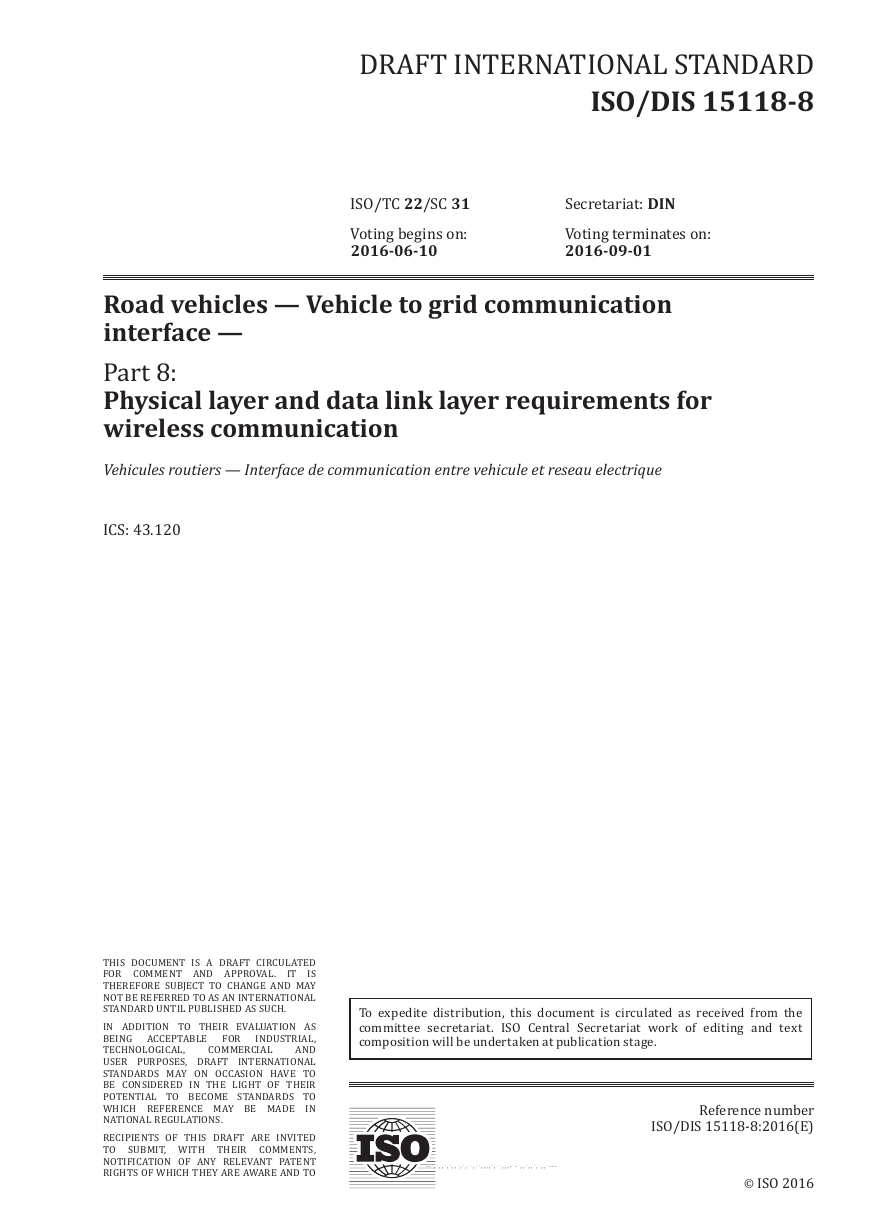
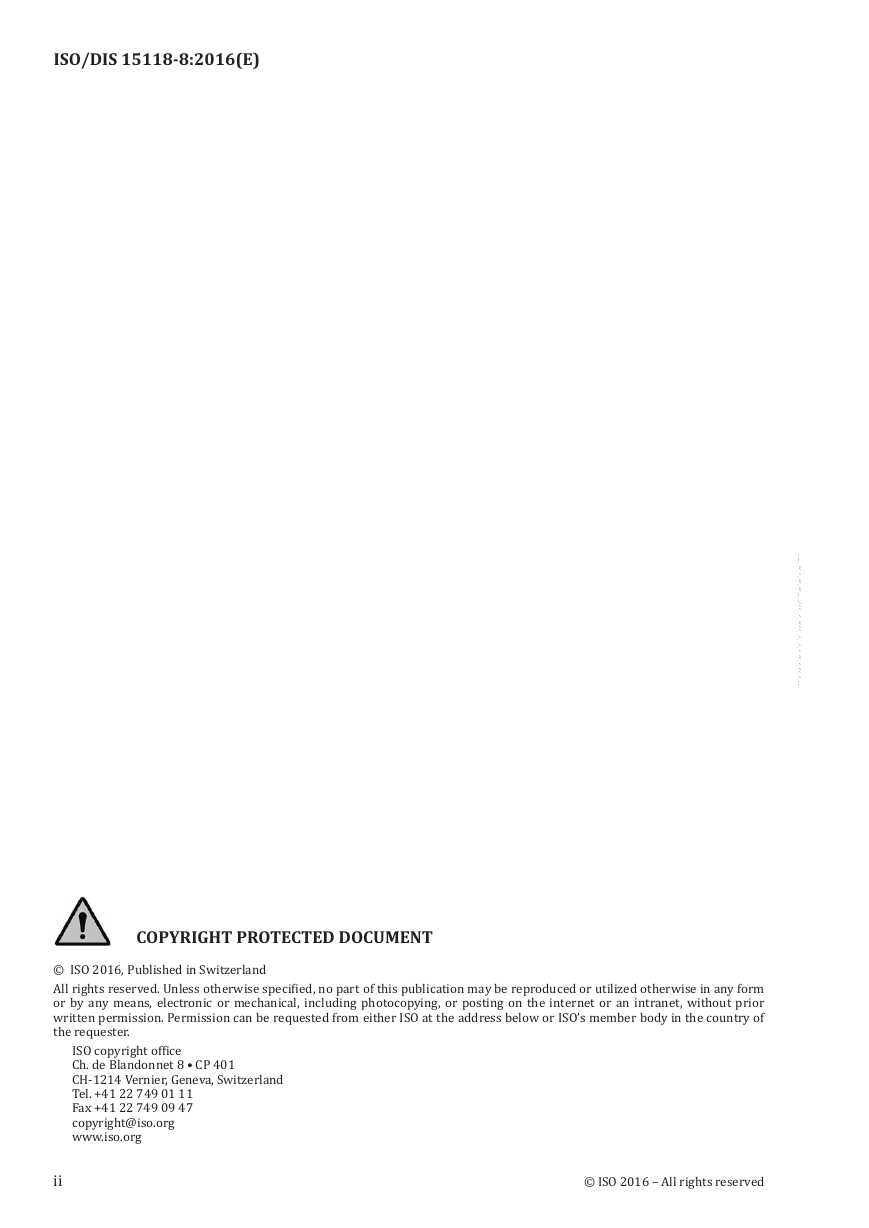
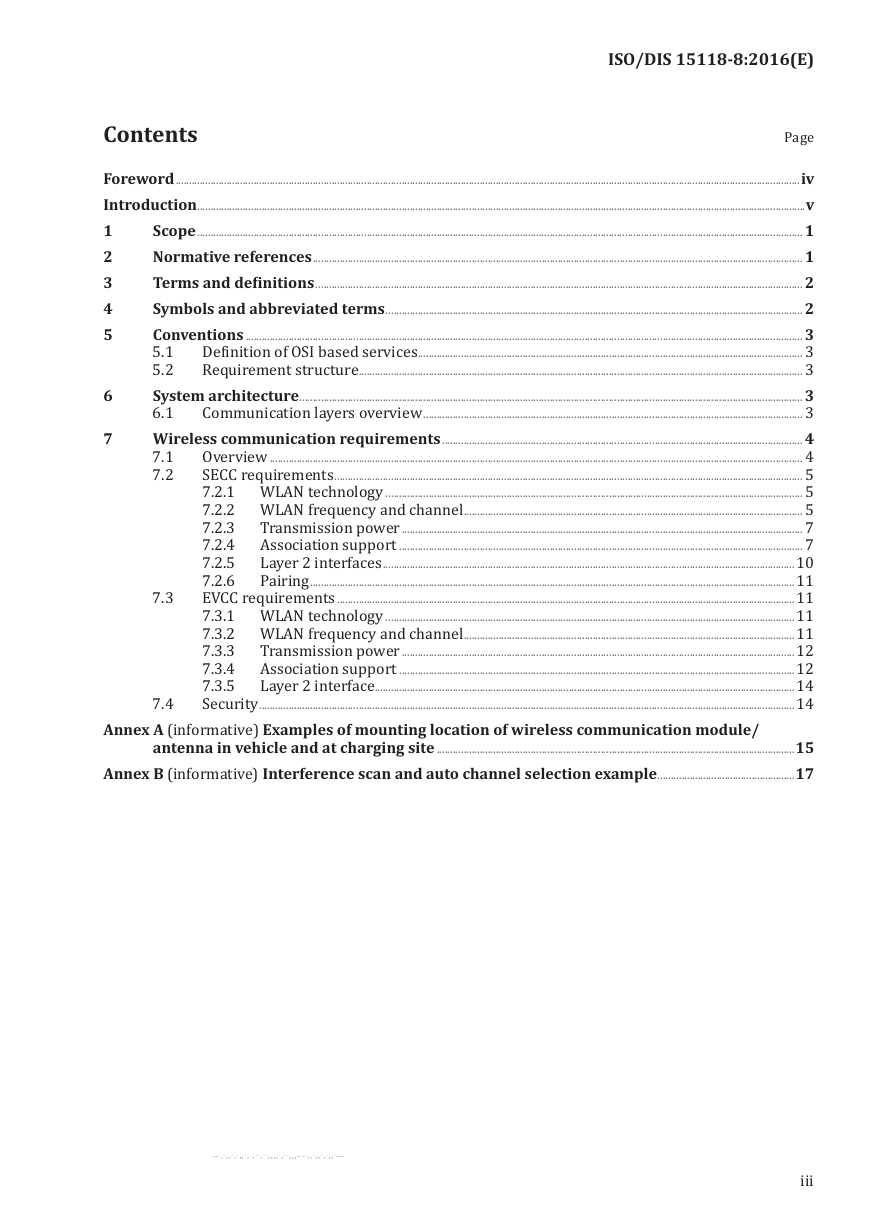
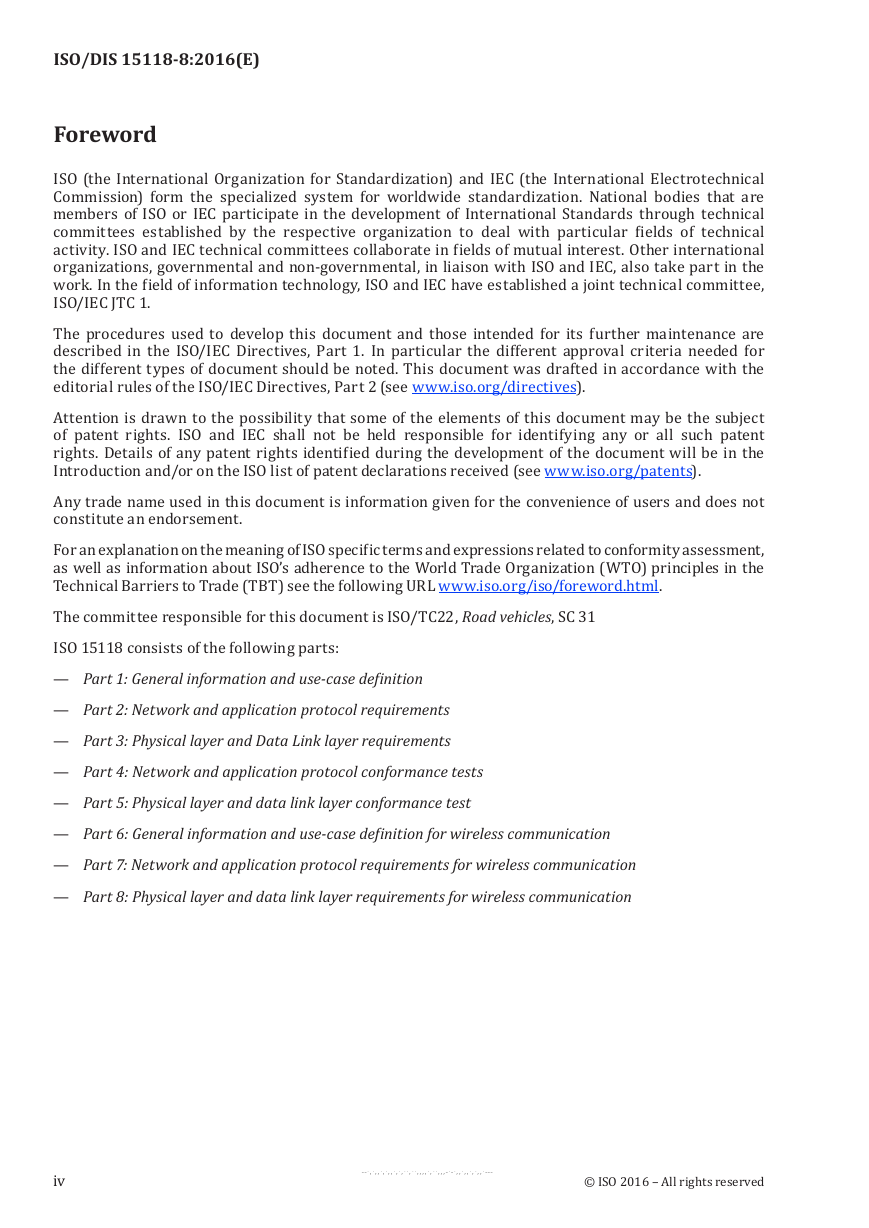


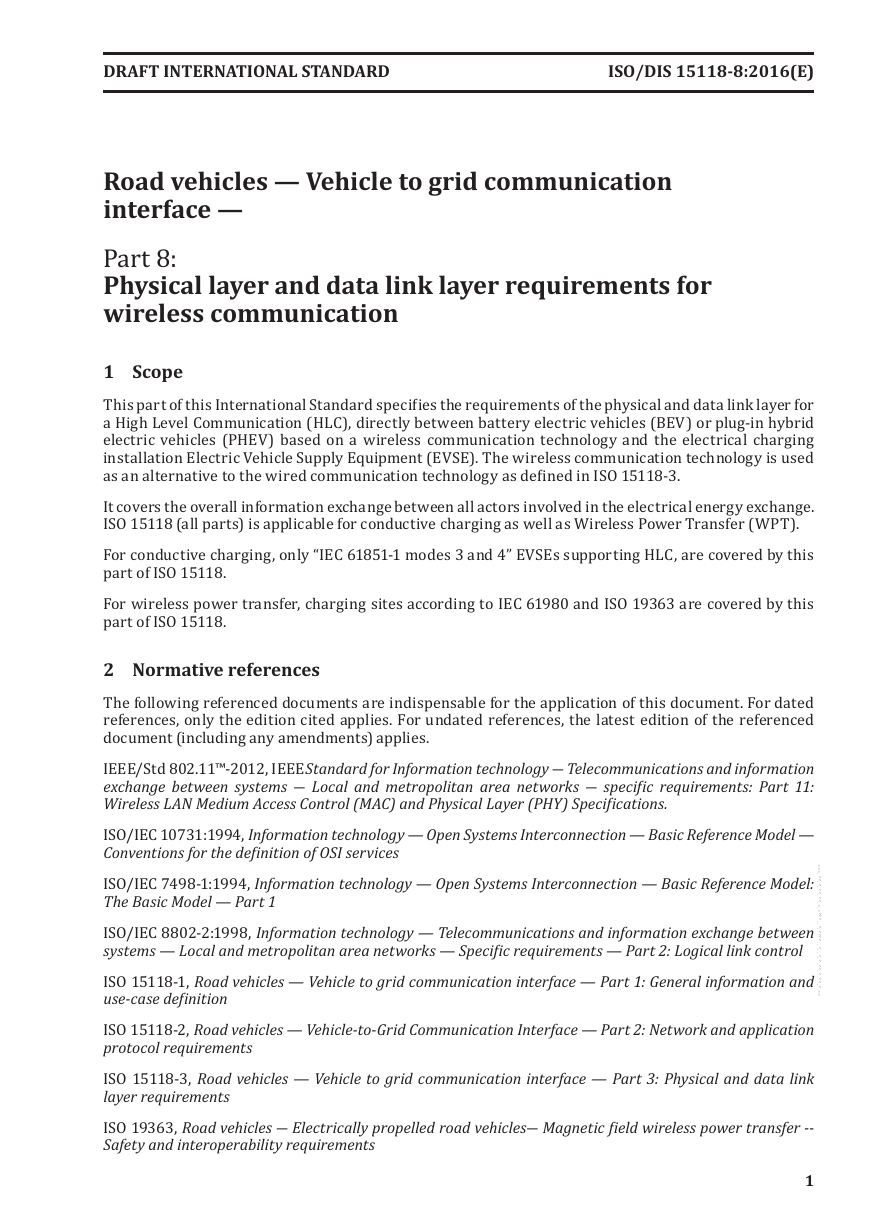
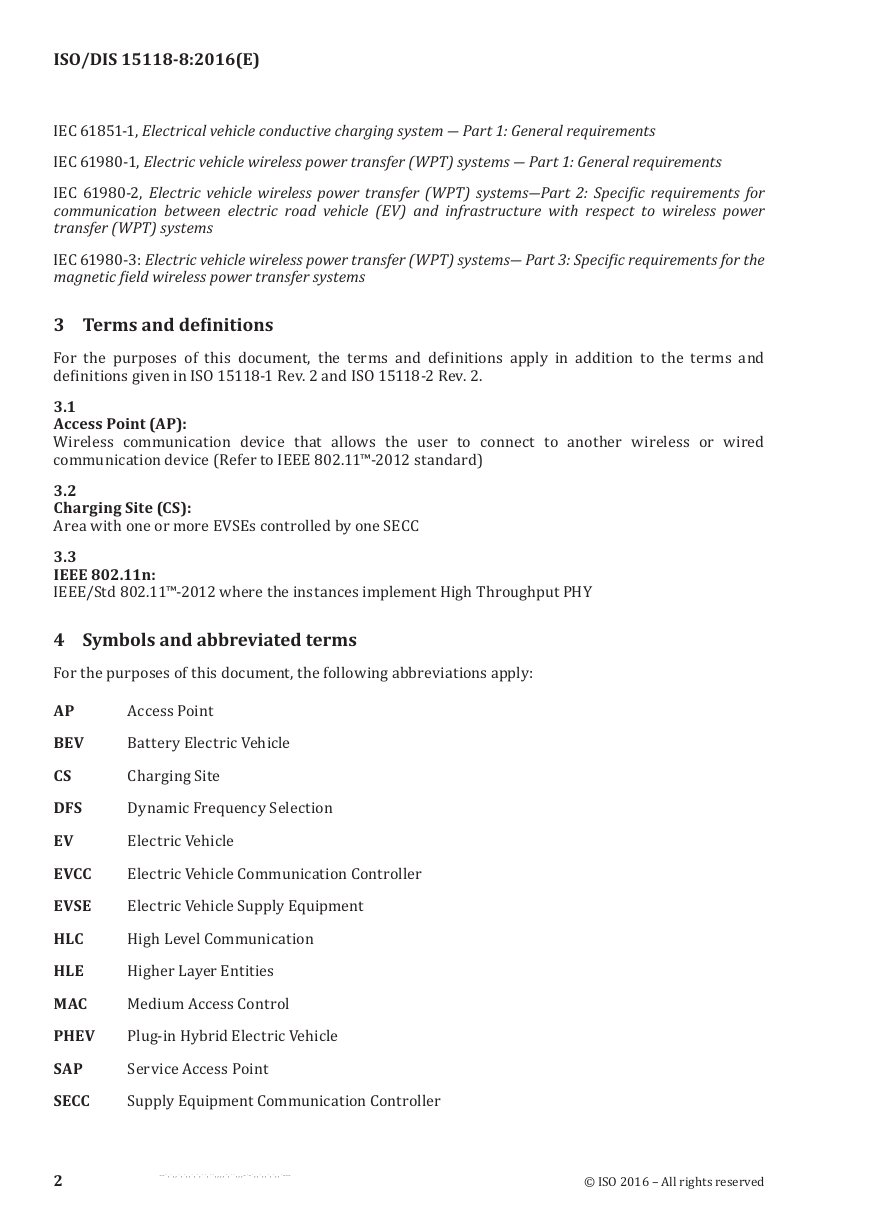








 2023年江西萍乡中考道德与法治真题及答案.doc
2023年江西萍乡中考道德与法治真题及答案.doc 2012年重庆南川中考生物真题及答案.doc
2012年重庆南川中考生物真题及答案.doc 2013年江西师范大学地理学综合及文艺理论基础考研真题.doc
2013年江西师范大学地理学综合及文艺理论基础考研真题.doc 2020年四川甘孜小升初语文真题及答案I卷.doc
2020年四川甘孜小升初语文真题及答案I卷.doc 2020年注册岩土工程师专业基础考试真题及答案.doc
2020年注册岩土工程师专业基础考试真题及答案.doc 2023-2024学年福建省厦门市九年级上学期数学月考试题及答案.doc
2023-2024学年福建省厦门市九年级上学期数学月考试题及答案.doc 2021-2022学年辽宁省沈阳市大东区九年级上学期语文期末试题及答案.doc
2021-2022学年辽宁省沈阳市大东区九年级上学期语文期末试题及答案.doc 2022-2023学年北京东城区初三第一学期物理期末试卷及答案.doc
2022-2023学年北京东城区初三第一学期物理期末试卷及答案.doc 2018上半年江西教师资格初中地理学科知识与教学能力真题及答案.doc
2018上半年江西教师资格初中地理学科知识与教学能力真题及答案.doc 2012年河北国家公务员申论考试真题及答案-省级.doc
2012年河北国家公务员申论考试真题及答案-省级.doc 2020-2021学年江苏省扬州市江都区邵樊片九年级上学期数学第一次质量检测试题及答案.doc
2020-2021学年江苏省扬州市江都区邵樊片九年级上学期数学第一次质量检测试题及答案.doc 2022下半年黑龙江教师资格证中学综合素质真题及答案.doc
2022下半年黑龙江教师资格证中学综合素质真题及答案.doc